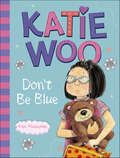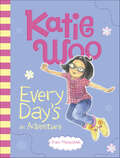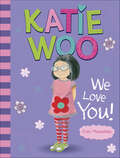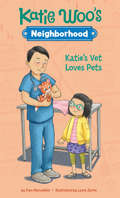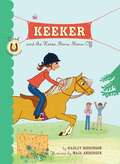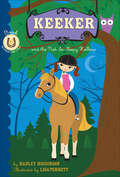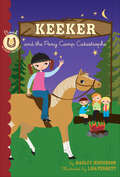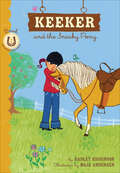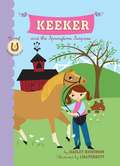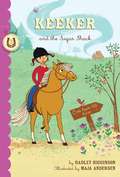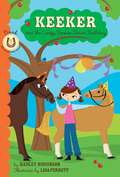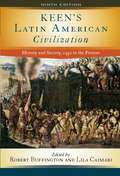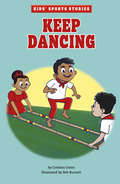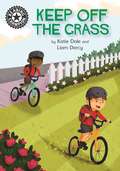- Table View
- List View
Katie Woo, Don't Be Blue (Katie Woo)
by Fran ManushkinEven Katie Woo has a bad day once in a while. Wheather it's a big rainstorm or a nasty case of the flu, things happen that make Katie feel scared, nervous, or sad. But don't worry! With her friends and parents by her side, Katie won't be blue for long.
Katie Woo, Every Day's an Adventure (Katie Woo)
by Fran ManushkinKatie Woo loves an adventure. She always finds a way to enjoy each new and unexpected thing that comes her way. From airplane trips to dance recitals, the fun never ends. Join Katie and have an adventure of your own!
Katie Woo, We Love You! (Katie Woo)
by Fran ManushkinFrom starting clubs to hosting sleepovers, Katie Woo is one fun friend! Come along on her big adventures and funny mishaps. Whether she's playing at home or working at school, everything Katie does has us singing, Katie Woo, we love you!
Katie's Friends and Neighbors (Katie Woo's Neighborhood)
by Fran ManushkinKatie Woo’s neighborhood is full of great people who make great friends! From Mr. Kenji, who’s training to be a nurse, to Miss Bliss, the neighborhood’s super-duper librarian, Katie’s neighbors all work together to make their neighborhood a wonderful place to live. Visit Katie’s friends and neighbors in this early chapter book by Fran Manushkin.
Katie's Friends and Neighbors (Katie Woo's Neighborhood)
by Fran ManushkinKatie Woo’s neighborhood is full of great people who make great friends! From Mr. Kenji, who’s training to be a nurse, to Miss Bliss, the neighborhood’s super-duper librarian, Katie’s neighbors all work together to make their neighborhood a wonderful place to live. Visit Katie’s friends and neighbors in this early chapter book by Fran Manushkin.
Katie's Friends and Neighbors (Katie Woo's Neighborhood)
by Fran ManushkinKatie Woo’s neighborhood is full of great people who make great friends! From Mr. Kenji, who’s training to be a nurse, to Miss Bliss, the neighborhood’s super-duper librarian, Katie’s neighbors all work together to make their neighborhood a wonderful place to live. Visit Katie’s friends and neighbors in this early chapter book by Fran Manushkin.
Katie's Vet Loves Pets (Katie Woo's Neighborhood)
by Fran ManushkinWhen Katie finds a sick kitten, she simply must help! She asks Dad to take the kitty for a trip to Dr. Wong's vet clinic. Dr. Wong helps animals of all shapes and sizes, from parrots that won't talk to iguanas that won't eat. Can he help the stray kitty too? Katie loves her community and that love is shown in Katie Woo's Neighborhood, an early chapter book series by author Fran Manushkin.
Kaushal Bodh (Vocational Education Activity Book) class 6 - NCERT - 25
by National Council of Educational Research and TrainingKaushal Bodh: Vocational Education Activity Book for Grade 6 has been developed by NCERT in alignment with the National Education Policy (NEP) 2020 and the National Curriculum Framework for School Education (NCF-SE) 2023. The book introduces vocational education at the middle stage by engaging students in practical, hands-on projects across three forms of work—life forms, machines and materials, and human services. It features six illustrative projects, such as creating a school kitchen garden, preparing a biodiversity register, developing maker skills, designing animations and games, establishing a school museum, and cooking without fire. Each project is designed to build creativity, critical thinking, collaboration, ecological awareness, and respect for the dignity of labour. Cross-cutting themes like sustainability, heritage, gender sensitivity, and inclusion are woven into activities, ensuring holistic development. With reflective questions, QR-linked resources, and teacher guidance, the book bridges classroom learning with real-life skills, preparing students for lifelong learning and responsible citizenship.
Kaushal Bodh (Vocational Education Activity Book) class 8 - NCERT - 25
by National Council of Educational Research and TrainingKaushal Bodh – Vocational Education Activity Book for Grade 8, developed by NCERT in line with the National Education Policy (NEP) 2020 and the National Curriculum Framework for School Education (NCF-SE) 2023, aims to promote skill-based learning through practical, project-driven activities. The book introduces students to vocational education under three categories—Work with Life Forms, Work with Machines and Materials, and Work in Human Services—helping them connect classroom concepts with real-life applications. It includes six illustrative projects such as Hydroponics: Growing Plants without Soil, Feeding and Caring for Farm Animals, Working with Wood and Bamboo, Home Automation, Water Audit for Water Management, and Advertising for Small Businesses. Each project is designed to develop core competencies like creativity, communication, critical thinking, teamwork, and environmental awareness. The activity book encourages students to explore, experiment, and learn by doing, fostering dignity of labour and self-reliance. It also integrates cross-cutting themes such as gender sensitivity, inclusion, Indian knowledge systems, and sustainability. Teachers are guided to assess students continuously through portfolios, self-evaluation, and peer assessment. Additionally, the Kaushal Mela at the year’s end provides a platform for students to showcase their vocational learning outcomes and innovations. Through this approach, Kaushal Bodh not only imparts technical and practical skills but also nurtures values of empathy, discipline, and respect for all forms of work, thus preparing students to become confident, responsible, and skilled citizens of a self-reliant India.
Kautilyachi Arthavyavshta First Semester FYBA New NEP Syllabus - RTMNU: कौटिल्याची अर्थव्यवस्था पहिले सत्र एफ.वाय.बी.ए. नवीन एन.इ.पी. अभ्यासक्रम - राष्ट्रसंत तुकडोजी महाराज नागपूर विद्यापीठ
by Prof. Dr. Rakshit Madan Bagde‘कौटिल्याची अर्थव्यवस्था’ हे प्रा. डॉ. रक्षित मदन बागडे लिखित पुस्तक प्राचीन भारतातील राजकारण, अर्थशास्त्र, लष्करी धोरण आणि प्रशासन या क्षेत्रांतील कौटिल्याच्या (चाणक्य) विचारांचे सखोल विश्लेषण करते. राष्ट्रसंत तुकडोजी महाराज नागपूर विद्यापीठ व संत गाडगेबाबा अमरावती विद्यापीठाच्या बी.ए. (अर्थशास्त्र) प्रथम वर्ष अभ्यासक्रमानुसार तयार करण्यात आलेले हे पुस्तक Indian Knowledge System (IKS) चा भाग आहे. कौटिल्याचे अर्थशास्त्र हे शासनाच्या विविध पैलूंवर – सुशासन, करप्रणाली, व्यापार, शेती, न्यायव्यवस्था, लष्करी संघटना, हेरगिरी, परराष्ट्र धोरण – यावर प्रकाश टाकते. यात सप्तांग सिद्धांत, राजमंडल सिद्धांत, साम-दाम-दंड-भेद, मत्स्य न्याय यांसारख्या तत्वांचे विवेचन असून, कौटिल्याचा दृष्टिकोन किती कालप्रासंगिक आणि व्यावहारिक होता हे स्पष्ट होते. हे पुस्तक फक्त शैक्षणिक संदर्भातच नाही, तर राज्यकारभार, धोरणनिर्मिती आणि प्रशासन या विषयात रस असणाऱ्यांसाठीही उपयुक्त ठरते. लेखकाने अभ्यासक्रमानुसार युनिटप्रमाणे विभागणी करून विषय सुबोध शैलीत मांडला आहे, जे विद्यार्थ्यांसाठी हे पुस्तक सहज समजणारे आणि अभ्यासोपयोगी बनवते.
Kavya Sarita (Hindi) F.Y.B.A. Pune University
by Suresh SalunkeKavya Sarita text book for First year from The Pune Universtity in Hindi.
Kavya-Vithi B.A. Sem-I - Ranchi University, N.P.U.
by Vindhyavasini Pande Arun Kumar Mithilesh SinghKavya - Vithi is a Hindi poerty book published by Bhasha Publisher and written by Dr.Vindhyavasini nandan Pande, Dr.Arun Kumar, and Dr.Mithilesh Kumar Singh. In this book the work is given about the poets and their poems.
Kaylee's Boots (Fountas & Pinnell Classroom, Guided Reading Kindergarten)
by Meredith Johnson Deanne KellsNIMAC-sourced textbook
Keeker and the Horse Show Show-Off
by Hadley Higginson Maya AndersenWhen a flyer arrives announcing an upcoming horse show, Keeker and Plum are determined to enter! They work hard to prepare, but will it be enough?
Keeker and the Not-So-Sleepy Hollow (Sneaky Pony Series #6)
by Hadley HigginsonKeeker and Plum are excited to visit family this summer, until they find out that a local town is haunted—by a headless horseman! When Keeker and Plum take a road trip to upstate New York, Keeker is sure it will be the best family vacation yet. (Plum, on the other hand, is not convinced!) Keeker is excited to splash in the neighborhood pond and ride ponies in the country with her cousins. What she doesn&’t know is that the nearby town of Sleepy Hollow holds a mystery that will make this a very ghostly getaway! Praise for the Sneaky Pony series &“These books are terrific first chapter books for young readers, quirky and compelling; the line drawings of the girl and her horse are simple but beguiling.&” —Entertainment Weekly &“I don&’t bandy the word &‘delightful&’ around lightly, but the retro flavor with contemporary appeal wins the Delightful Derby, and I am so happy to be able to recommend a romp down a reading trail that little girls will really enjoy.&” —PlanetEsme
Keeker and the Pony Camp Catastrophe: Book 5 in the Sneaky Pony Series (Sneaky Pony Series #5)
by Hadley HigginsonJust when summer starts to seem not so sunny, a crazy adventure mends fences between Keeker and Plum and their arch rivals. Keeker and Plum get to go to sleepaway camp for a whole week. But fun turns to surprise when Keeker learns that her bunkmate is none other than her horse-show rival, Tifni. The girls put aside their differences and become fast friends, but when Tifni&’s spirited pony bolts, Keeker has to decide whether to play it safe or save her friend. Praise for the Sneaky Pony series &“These books are terrific first chapter books for young readers, quirky and compelling; the line drawings of the girl and her horse are simple but beguiling.&” —Entertainment Weekly &“I don&’t bandy the word &‘delightful&’ around lightly, but the retro flavor with contemporary appeal wins the Delightful Derby, and I am so happy to be able to recommend a romp down a reading trail that little girls will really enjoy.&” —PlanetEsme
Keeker and the Sneaky Pony: Book 3 In The Sneaky Pony Series (Sneaky Pony Series #1)
by Hadley HigginsonSaddle up for a wild ride when a young girl finally gets the pony she&’s always dreamed of—and has some misadventures she never could have imagined. Meet Catherine Corey Keegan Dana (everyone calls her Keeker). What she wants most of all is a pony. Meet Plum. Plum is a Shetland pony (who&’s known to be a teeny bit sneaky). She rarely, if ever, thinks about little girls. She certainly doesn&’t want one. When Plum moves to Keeker&’s farm, Keeker faces the challenge of winning a pony&’s trust and friendship. And when Plum and Keeker find themselves lost in the woods, they learn that working together is the best way to get out of a fix. This fast-paced story of adventure and friendship will have new readers galloping back for more. &“Sepia-toned art and type give this tale a pleasingly old-fashioned yet timeless feel. The ample full-page and spot illustrations plus short sentences tailor this early chapter book to reluctant readers—particularly those with a soft spot for horses.&” —Publishers Weekly
Keeker and the Springtime Surprise
by Hadley Higginson Lisa PerrettIn the fourth adventure in the Sneaky Pony series, Keeker and Plum have discovered all kinds of surprising things on the farm: a baby bird to take care of, a family of groundhogs living in the field. They also learn that Mrs. Dana's horse is going to have a baby. But soon Keeker and Plum get tired of being ignored and Keeker decides staging a play will be just the thing to win back her parents' attention. By the time the play is over, Keeker and Plum receive a surprise more exciting than they ever could have imagined!
Keeker and the Sugar Shack
by Hadley Higginson Maya AndersenIt's mud season in Vermont and Keeker is so bored she doesn't know what to do. But when a new neighbor starts mixing a strange concoction in the shack on her farm, Keeker and Plum get wrapped up in an exciting investigation!
Keeker and the Upside-Down Day
by Hadley Higginson Lisa PerrettThe delightful, timeless Sneaky Pony series concludes with Keeker and the Crazy, Upside-Down Birthday. Keeker's birthday is always full of surprises. But when she discovers what her parents are planning for this year's birthday surprise, Keeker is sure it will ruin her life! When she decides to run away with her pony Plum, Keeker learns that change can be exciting and that no matter what, some friendships will always remain true.
Keen's Latin American Civilization: History and Society, 1492 to the Present
by BuffingtonKeen's Latin American Civilization introduces readers to the sweeping panorama of Latin American history through a classic collection of primary documents. More than 140 readings, organized chronologically and placed in context by insightful introductory notes and essays, provide vivid glimpses of life in Latin America from the Conquest to the colonial and republican eras to contemporary Latin America. In the ninth edition, editors Robert Buffington and Lila Caimari document dramatic recent changes in Latin America, including the resurgence of leftist governments in South and Central America, the feminization of politics from the grassroots to the presidency, the devastating effects of narco-trafficking and political corruption on law and order, and growing concerns about the environment.
Keep Dancing (Kids' Sports Stories)
by Cristina OxtraLito is proud of his Filipino heritage, and he's one of the best dancers in his folk dance group. He and his sister, Nenita, plan to perform at their school's spring festival. When snickering classmates threaten to derail Lito's confidence, he needs to dig deep and keep dancing.
Keep Off the Grass: Independent Reading 13 (Reading Champion #305)
by Katie DaleSimon and Tariq are best friends. But when Simon starts taking a shortcut through somebody's garden, and Tariq is not happy to do so, their friendship is tested. Then Tariq gets into trouble because of Simon's actions. Will Simon prove to be a good friend after all?Reading Champion offers independent reading books for children to practise and reinforce their developing reading skills.Fantastic, original stories are accompanied by engaging artwork and a reading activity. Each book has been carefully graded so that it can be matched to a child's reading ability, encouraging reading for pleasure.The Key Stage 2 Reading Champion Books are suggested for use as follows:Independent Reading 11: start of Year 3 or age 7+Independent Reading 12: end of Year 3 or age 7+Independent Reading 13: start of Year 4 or age 8+Independent Reading 14: end of Year 4 or age 8+Independent Reading 15: start of Year 5 or age 9+Independent Reading 16: end of Year 5 or age 9+Independent Reading 17: start of Year 6 or age 10+Independent Reading 18: end of Year 6 or age 10+
Keep the Line Zipping! (Into Reading, Level Q #47)
by Peter Millett Scott FraserNIMAC-sourced textbook
